The Best-Paying Construction Jobs in the U.S.
Note: This is the most recent release of our Best-Paying Construction Jobs in the U.S. study. To see data from previous years, please visit the Full Results section below.
The construction industry has experienced a period of heightened activity over the past several years, driven by significant growth in private residential construction and record increases in public funding for infrastructure projects. With the enactment of key legislations such as the Infrastructure Investment and Jobs Act, Inflation Reduction Act, and CHIPS and Science Act, the federal government has committed to investing over $2 trillion in areas including transportation, energy, manufacturing, broadband, and more over the next decade.
These factors are poised to sustain growth in the industry. Despite already being one of the fastest-growing sectors since the pandemic declaration, the U.S. Bureau of Labor Statistics foresees construction employment continuing to grow at a rate in line with the national average over the next decade. Occupations projected to be particularly sought-after include solar photovoltaic installers (with a projected increase of 22.3%) and highway maintenance workers (anticipated to rise by 7.9%). This high demand for construction workers translates to competitive wages.
Construction Wages Compared
Construction workers are well paid compared to other workers with similar levels of education
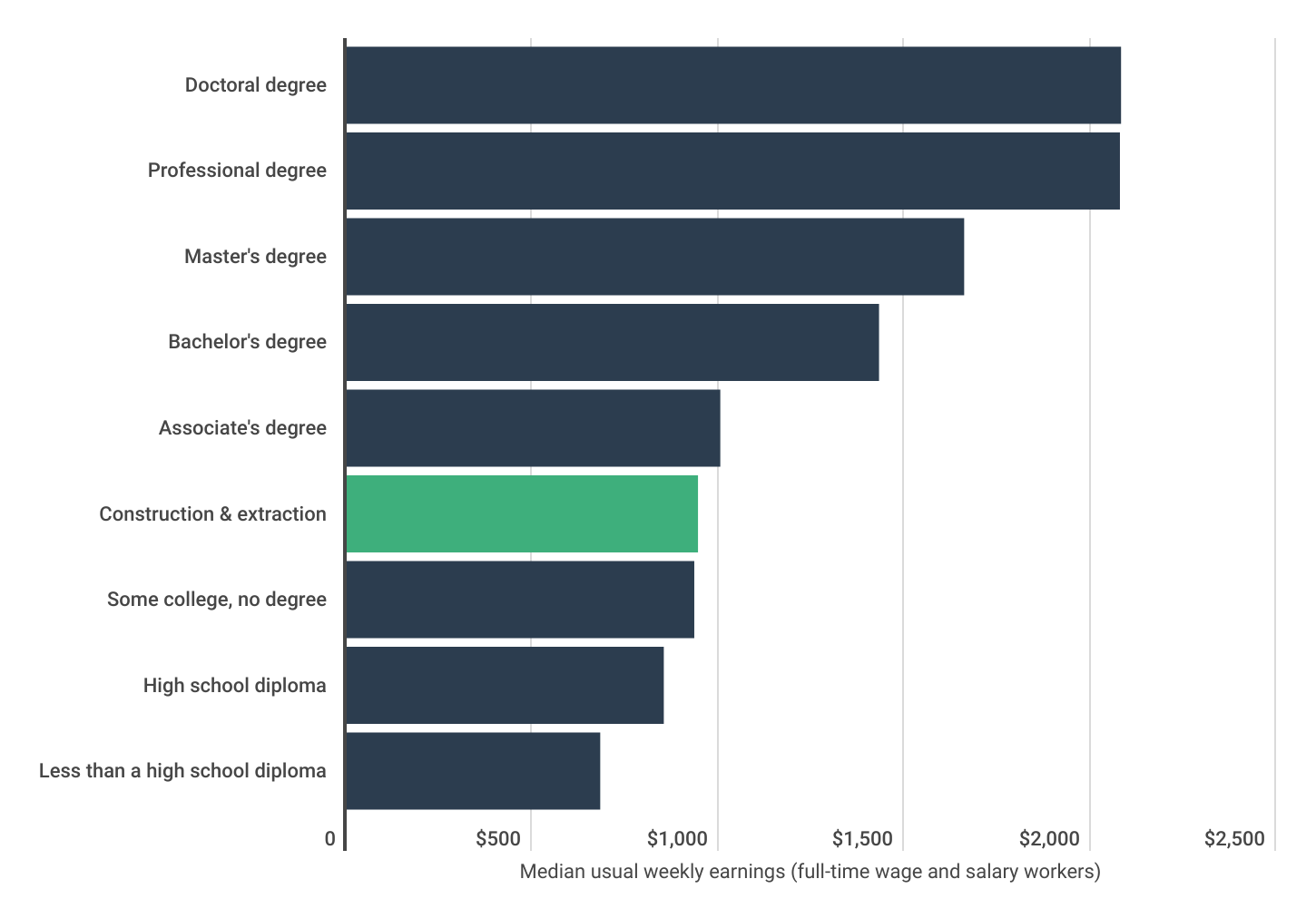
Construction occupations tend to offer strong wages relative to the educational requirements for entry. A significant proportion of these roles do not necessitate formal education or a high school diploma, yet they yield a median weekly income of $945—approaching the $1,005 median weekly earnings of individuals holding an associate’s degree. High school graduates typically earn a median of $853 per week, while those without a diploma earn $682.
RELATED
Many construction businesses lack adequate insurance. Some of the most important policies are builders risk insurance for your projects, commercial auto insurance for your vehicles, and workers compensation insurance for your employees.
Construction Wages by State
Hawaii, Illinois, and Massachusetts report the highest median hourly wages for construction workers
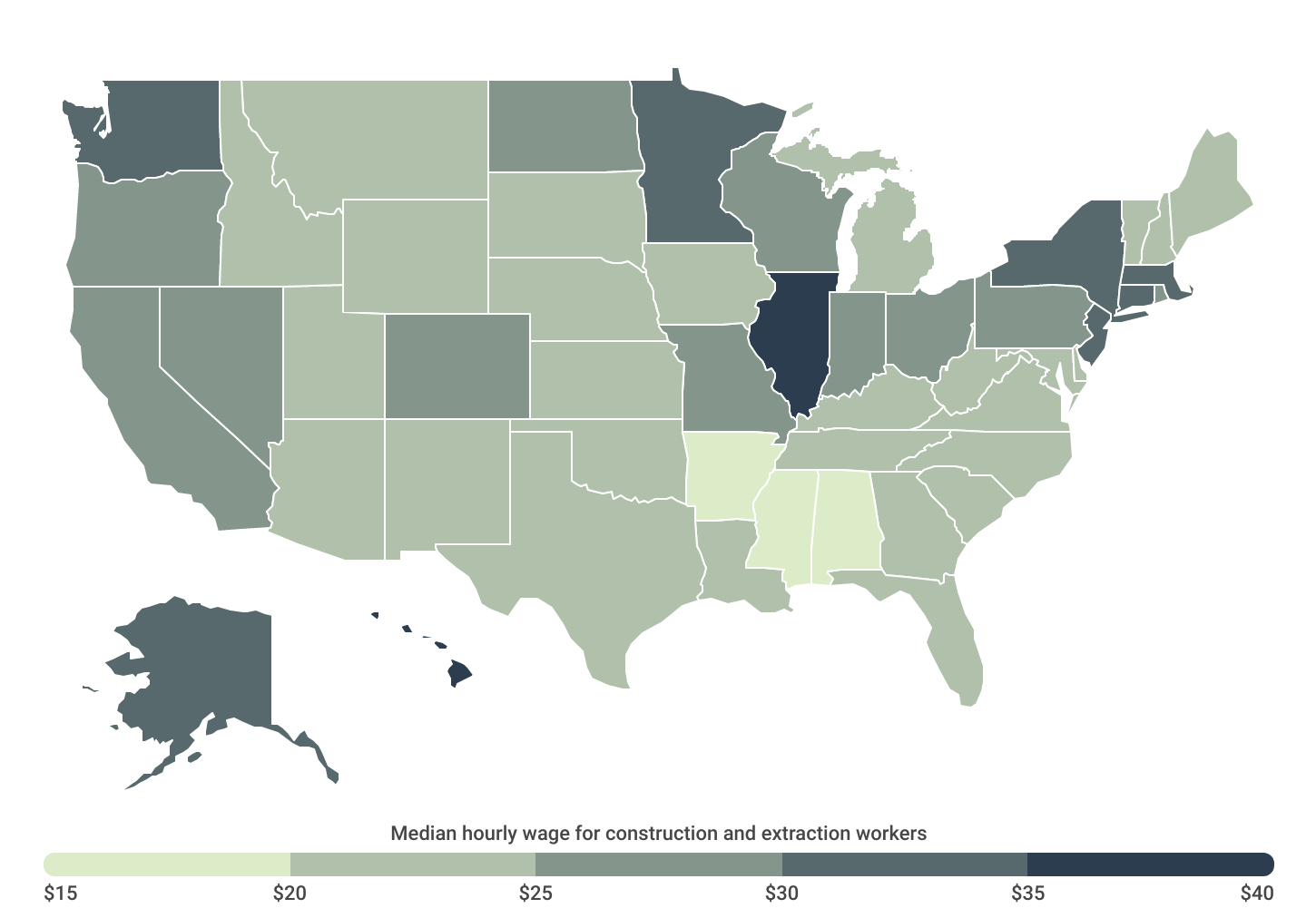
Construction workers generally receive competitive compensation, though their earnings can significantly vary based on their location. The West Coast, including Alaska and Hawaii, along with select regions in the Midwest and Northeast, offer construction workers higher hourly wages compared to other parts of the country. For instance, Hawaii and Illinois boast median hourly wages exceeding $35, while Massachusetts and Alaska approach $33 per hour. Conversely, numerous Southern states pay less than $22 per hour for construction labor.
Moreover, the nature of the construction role significantly influences the level of compensation. Specialized positions such as elevator installers, boilermakers, and pile driver operators tend to command higher rates. However, even general construction supervisors, building inspectors, and more common tradespeople like electricians also rank among the highest-paying jobs in the construction industry.
Below is a complete breakdown of hourly and annual wages for nearly 50 of the most common construction occupations. The analysis was conducted by Construction Coverage using data from the U.S. Bureau of Labor Statistics. For more information, refer to the methodology section.
The Highest-Paying Construction Jobs

Photo Credit: Dagmara K / Shutterstock
10. Plumbers, Pipefitters, and Steamfitters
- Median hourly wage: $28.89
- Median annual wage: $60,090
- Total employed nationally: 482,700
- Projected 10-year employment growth: +2.3%
- Percentage of workers that are self-employed: 9.6%
Plumbers, pipefitters, and steamfitters install and repair the structures that carry liquids or gasses from one place to another. There are nearly 500,000 workers nationally, and they can specialize in a range of work, from common household plumbing to more advanced industrial systems.
TRENDING
As your construction business grows, accounting becomes increasingly complex. Whether you are trying to track expenses by job, employee hours, or overall cash flow, having the right accounting tool will make all the difference. The best construction accounting software products streamline these tasks so you can focus on growing your business.

Photo Credit: Varavin88 / Shutterstock
9. Electricians
- Median hourly wage: $28.96
- Median annual wage: $60,240
- Total employed nationally: 762,600
- Projected 10-year employment growth: +6.4%
- Percentage of workers that are self-employed: 7.9%
Electricians connect wired devices to the systems that power, communicate, or control them. The work involves installation, maintenance, and repair of electrical power, phone, internet, cable, lighting, and control systems in homes, businesses, farms, and industrial locations. This is one occupation that pays well, can be done almost anywhere, and is projected to grow significantly over the next decade.

Photo Credit: Bannafarsai Stock / Shutterstock
8. Structural Iron and Steel Workers
- Median hourly wage: $29.09
- Median annual wage: $60,500
- Total employed nationally: 71,600
- Projected 10-year employment growth: +1.8%
- Percentage of workers that are self-employed: 6.4%
Structural iron and steel workers are skilled professionals who assemble and install the framework for buildings, bridges, and other structures using steel girders, beams, and columns. They interpret blueprints, use heavy machinery to position and secure the materials, and ensure that the structures meet safety and engineering standards.

Photo Credit: schankz / Shutterstock
7. Tapers
- Median hourly wage: $29.98
- Median annual wage: $62,360
- Total employed nationally: 18,100
- Projected 10-year employment growth: -2.3%
- Percentage of workers that are self-employed: 21.7%
Tapers have a specialized role in the process of finishing interior walls before they’re painted or wallpapered. While full-time tapers are not very common, the job pays well for those who have the skill and available work.
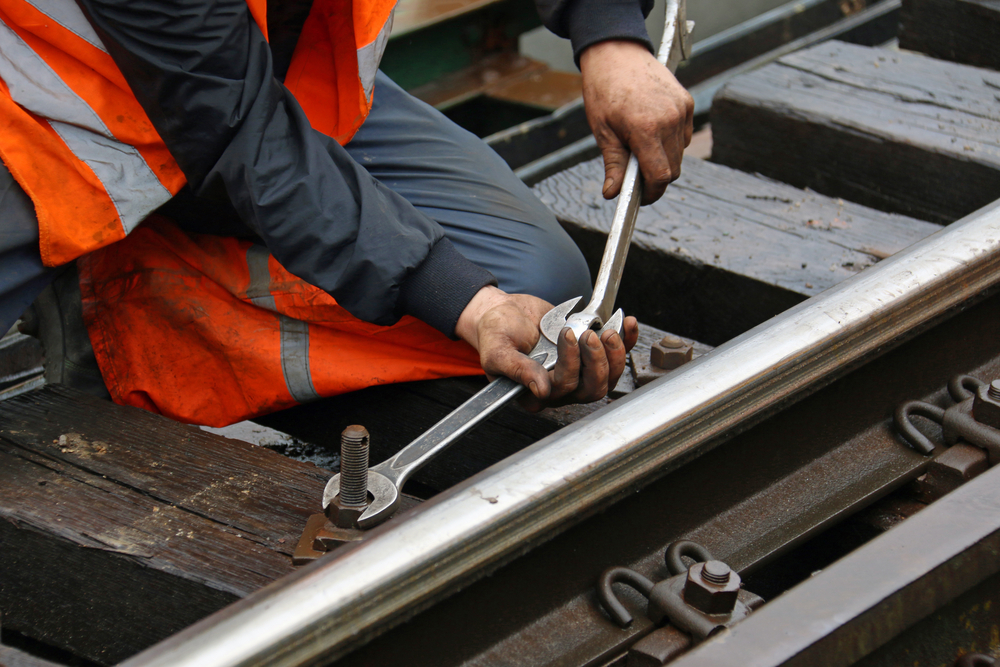
Photo Credit: Mrak.hr / Shutterstock
6. Rail-Track Laying and Maintenance Equipment Operators
- Median hourly wage: $30.40
- Median annual wage: $63,230
- Total employed nationally: 16,500
- Projected 10-year employment growth: +1.4%
- Percentage of workers that are self-employed: N/A
These railroad workers specialize in laying track for trains and related equipment, as well as maintaining and repairing both the track and its underlying ties. While these jobs pay well, the opportunities to find one are limited.
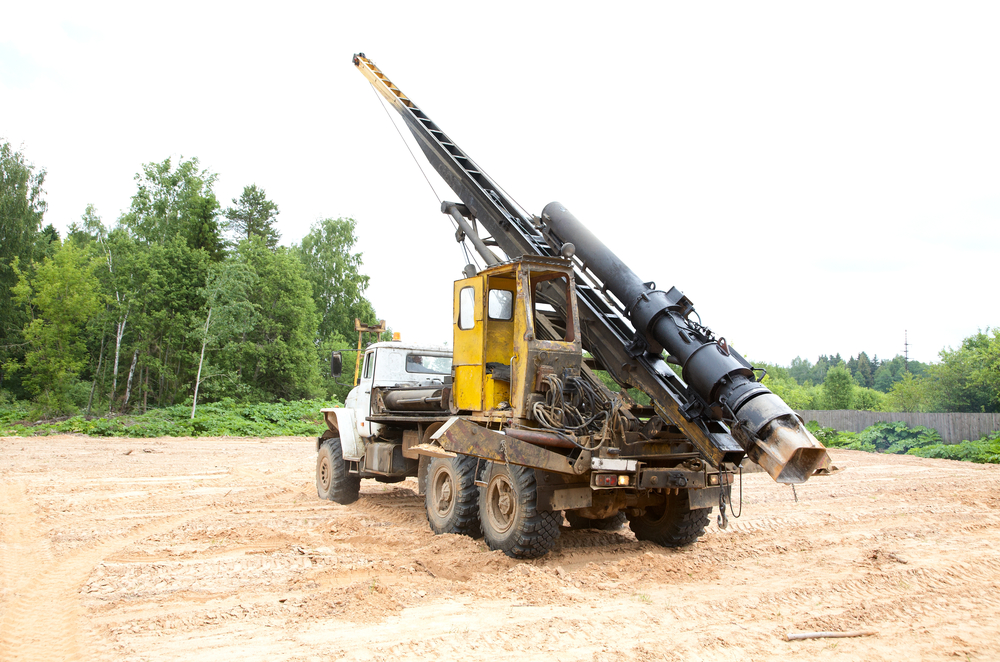
Photo Credit: alarich / Shutterstock
5. Pile Driver Operators
- Median hourly wage: $30.92
- Median annual wage: $64,310
- Total employed nationally: 3,300
- Projected 10-year employment growth: +3.2%
- Percentage of workers that are self-employed: 2.6%
Pile driver operators drive pilings into the ground for the construction of structures like retaining walls and foundations for buildings and bridges. There are fewer than 4,000 employed nationally, but opportunities are projected to grow.
RELATED
If your employees use vehicles to transport goods and tools between job sites, make sure you have adequate truck insurance coverage. Commercial truck insurance provides financial protection against injury, damage to vehicles, and damage to cargo.

Photo Credit: Sorn340 Studio Images / Shutterstock
4. Construction and Building Inspectors
- Median hourly wage: $31.00
- Median annual wage: $64,480
- Total employed nationally: 142,400
- Projected 10-year employment growth: -1.5%
- Percentage of workers that are self-employed: 7.1%
Construction and building inspectors leverage their comprehensive knowledge of blueprints, building codes, and local regulations to ensure that projects are executed in compliance with safety and legal standards. Typically requiring relevant experience and professional licensure or certification, inspectors are sought-after professionals in regions experiencing construction activity.

Photo Credit: Alexxxey / Shutterstock
3. Boilermakers
- Median hourly wage: $32.17
- Median annual wage: $66,920
- Total employed nationally: 13,700
- Projected 10-year employment growth: -4.0%
- Percentage of workers that are self-employed: N/A
Boilermakers are skilled professionals tasked with assembling and maintaining steam boilers used for heating buildings or generating electricity. Their responsibilities encompass the construction and installation of tanks, fittings, valves, regulators, and other components, along with tasks like testing, cleaning, and performing repairs. Although it ranks among the higher-paying roles in the construction industry, the number of available positions is expected to decrease over the next decade.

Photo Credit: sirtravelalot / Shutterstock
2. First-Line Supervisors of Construction Trades and Extraction Workers
- Median hourly wage: $35.62
- Median annual wage: $74,080
- Total employed nationally: 809,900
- Projected 10-year employment growth: +2.5%
- Percentage of workers that are self-employed: 10.0%
First-line supervisors are the leaders who actively coordinate and direct the work at construction or extraction sites. They are responsible for planning and preparing the day’s work so it unfolds smoothly. There are more than 800,000 jobs nationally—a number projected to grow in the years ahead.
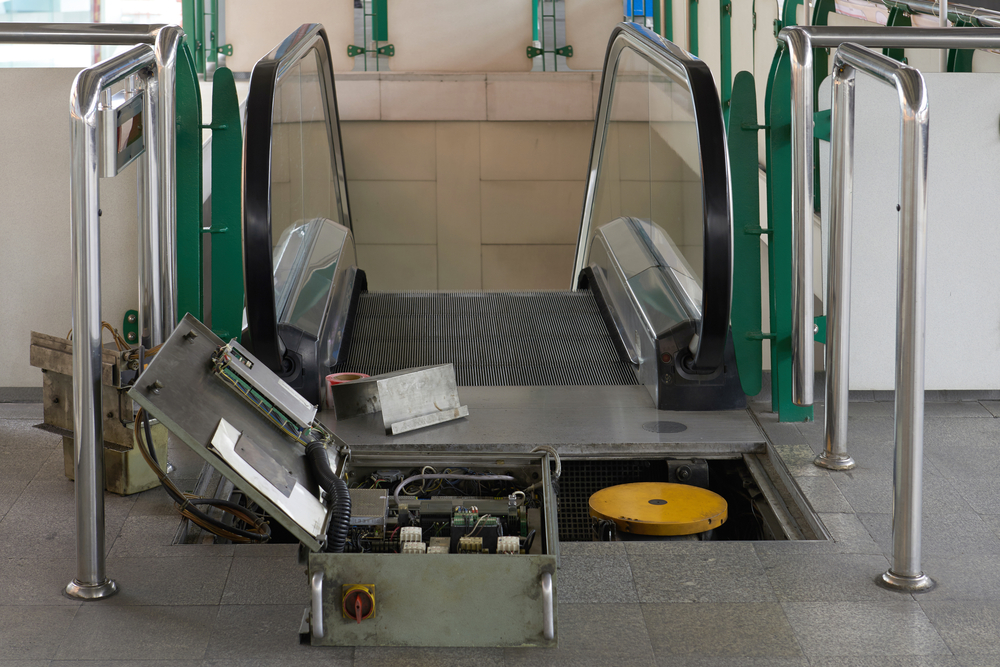
Photo Credit: MiloLabrador / Shutterstock
1. Elevator and Escalator Installers and Repairers
- Median hourly wage: $47.60
- Median annual wage: $99,000
- Total employed nationally: 25,100
- Projected 10-year employment growth: +1.5%
- Percentage of workers that are self-employed: N/A
Elevator and escalator installers specialize in the installation, upkeep, and repair of vertical transportation systems commonly found in hotels, office buildings, malls, and airports. While the role may entail working in confined spaces and elevator shafts, these professionals receive substantial compensation for their time.
Methodology & Detailed Findings
To find the best-paying construction jobs, researchers analyzed data from the U.S. Bureau of Labor Statistics 2022 Occupational Employment and Wage Statistics and 2022 Employment Projections surveys. Occupations were ranked according to median hourly wage. Researchers also included median annual wages, total employment, and projected 10-year employment growth (2022–2032). The percentage of workers that are self-employed for each occupation was also included. Compensation data includes both part-time and full-time wage and salary workers; whereas, employment data includes all workers (including those who are self-employed).
References
- U.S. Census Bureau. (2023, December 1). Total Construction Spending: Total Construction in the United States [TTLCONS]. https://fred.stlouisfed.org/series/TTLCONS. Retrieved December 30, 2023.
- Justin Badlam et al. (2022, October 24). The Inflation Reduction Act: Here’s what’s in it. McKinsey & Company. https://www.mckinsey.com/industries/public-sector/our-insights/the-inflation-reduction-act-heres-whats-in-it. Retrieved December 30, 2023.
- USAFacts. (2023, November 3). Has leisure and hospitality employment recovered from the pandemic?. https://usafacts.org/articles/has-leisure-and-hospitality-employment-recovered-from-the-pandemic/. Retrieved December 30, 2023.
- U.S. Bureau of Labor Statistics. (2023, April 25). Occupational Employment and Wage Statistics [Dataset]. https://www.bls.gov/oes/. Retrieved December 30, 2023.
- U.S. Bureau of Labor Statistics. (2023). Employment Projections. https://www.bls.gov/emp/. Retrieved December 30,2023.
Full Results
Each company featured in our guides has been independently selected and reviewed by our research team. If you select one of these companies and click on a link, we may earn a commission.
By clicking on these links, you may be taken to one of our insurance partners. The specific company listed here may or may not be included in our partner’s network at this time.
